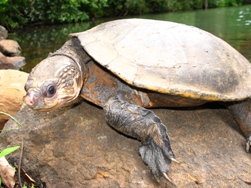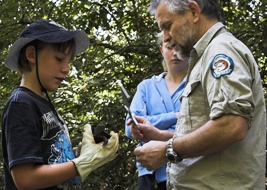Johnstone River snapping turtle

Common name: Johnstone River snapping turtle
Scientific name: Elseya irwini (Johnstone)
Family: Chelidae
Conservation status: The Johnstone River snapping turtle is listed as Least Concern in Queensland (Nature Conservation Act 1992).
Description
The Johnstone River snapping turtle is one of the larger species within the group of turtles known as the northern snapping turtle, or “dentata”, group. Females have been recorded with straight carapace lengths (SCL) of up to 34cm and can weigh up to 4.5kg. The largest male recorded had a SCL of 24.5cm and weighed 1.7kg.
Johnstone River snapping turtles are a short-necked species that typically have a dark brown to black carapace (shell). Large females often have distinctive areas of white colouration on their nose and throat, or in some cases a pink nose.
Habitat and distribution
The Johnstone River snapping turtle occurs in the North and South Johnstone Rivers in north-east Queensland. Within this range their distribution appears to be patchy, as they are mostly found in pool-riffle systems. The pools are usually deep (greater than three metres in depth) and often between shallow, riffle runs which can be over 100m in length. During the tropical wet season the level of the Johnstone River rises and falls dramatically in response to heavy rainfall, and flooding is not an uncommon occurrence.
Life history and behaviour
The Johnstone River snapping turtle nests in the dry season (April–July), and nest sites include a mown, lawn-covered bank and a loamy spit. Clutch sizes vary between 8 and 11 eggs, which are sometimes eaten by native predators such as bandicoots, rodents and goannas. Eggs hatch in the early wet season, with hatchlings measuring 43–46mm in length. The lifespan of the Johnstone River snapping turtle is unknown, although by counting the annual growth rings (annuli) on the shells of large female turtles they have been estimated to be at least 30 years old.
The Johnstone River snapping turtle is active both during the day and night throughout the year. During the day, adults are confined to the deeper pools but will emerge during the night to feed on algae that covers the boulders in shallow riffle zones. Juveniles are most often observed in shallow stony riffle areas, or in shallow stony bottom pools.
In common with other “snapper” turtles, the Johnstone River snapping turtle is mainly herbivorous. Adults will eat fruit, algae, aquatic plants and non-native pasture grasses (when the river floods), but show a strong preference for leaf matter and stems, which fall into the water from plants along the banks of the river. Animal matter, such as shrimp and carrion, are also consumed on occasion.
Threatening processes
Major threats to the Johnstone River snapping turtle are:
- Clearing of riparian vegetation – A large proportion of the habitat for the Johnstone River snapping turtle has been cleared for agriculture, rural-residential and urban development. Clearing of riparian vegetation can lead to habitat degradation through river bank erosion, weed invasion, loss of food sources, and a decline in water quality.
- Reduced water quality – Pollution and sedimentation, and alteration of river hydrology has occurred in the Johnstone River catchment. The resulting increase in turbidity and reduced oxygen levels has been found to be detrimental to the Johnstone River snapping turtle in laboratory studies. Although the impacts on the wild population are unknown, this species belongs to a suite of habitat specialist species that employ cloacal respiration, which is dependent on high water quality.
Other threats to the Johnstone River snapping turtle include:
- Weeds – The invasion of weeds can choke waterways, smother nesting sites, and prevent the re-establishment of native food plants for the Johnstone River snapping turtle.
- Feral pigs – Although feral pigs can eat the eggs and destroy the nests of Johnstone River snapping turtles, their current impact appears to be minimal.

Recovery actions
Staff from the department are working with community volunteers to monitor the Johnstone River snapping turtle, in the higher altitude of their range, in order to clarify their status and help guide management actions.
Recovery actions that would benefit the Johnstone River snapping turtle are to:
- Identify important areas of habitat for the Johnstone River snapping turtle; communicate this information to landholders, local government and other stakeholders; and, use this information to inform decisions made on vegetation clearing permits, planned developments, and habitat restoration.
- Encourage land managers to retain riparian vegetation.
- Encourage new sub-divisions and other developments to be set back from the river by at least 50m.
- Encourage land managers to restore areas of degraded river banks.
- Encourage land managers to minimise sediment and nutrient run-off into waterways.
- Encourage land managers to control invasive weeds, such as common guava (Psidium guajava) and para grass (Urochloa mutica).
Related information
Freeman, AB 2010. Saving a living fossil: identification and mitigation of threats to the conservation status of the freshwater turtle, Elseya lavarackorum. Unpublished report prepared for the department of Environment, Water, Heritage and the Arts, Canberra. 63p. (see availability) .
Freeman, AB, Curran, T 2009. Johnstone River snapper (Elseya stirlingi) on the Atherton Tablelands, summary report for the 2008 monitoring season. Department of Environment and Resource Management, Atherton. 16p. (see availability) .
Freeman, AB, Curran, T 2010. Johnstone River snapper (Elseya stirlingi) on the Atherton Tablelands, summary report for the 2009 monitoring season. Unpublished report prepared for Department of Environment and Resource Management, Atherton. 12pp. (see availability) .
Freeman, AB 2012. Johnstone River snapper (Elseya irwini Johnstone) on the Atherton Tablelands, summary report for the 2011 monitoring season. Department of Environment and Resource Management, Atherton. 16p. (see availability) .
Available from the library catalogue
The documents referred to on this page are available from the department's online library catalogue.


